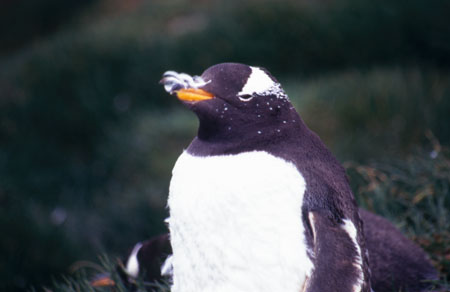Gentoo Penguins
Pygoscelis papua
Introduction
Description
Range and Population
Breeding
Food and Predators
Photo Gallery
Where to See Gentoo Penguins

Introduction
Gentoo penguins are related to adelie and chinstrap penguins, but are larger than both of these and have a destintive white patch behind their eyes. They also have destinctively long tail feathers which are often cocked up when they are swiming on the surface, making them easy to spot.
Description
Size: 75 to 90cm, or 30 to 35 inches tall
Weight: 5.5 to 8kg, 12 to 18 pounds
Lifespan: 20 Years
Range and Population
Gentoo penguins cover a wide territory from the Antarctic Peninsula to sub-antarctic islands such as Crozet, Prince Edward, Kerguelen, South Georgia, Heard, and Macquarie Islands. It is estimated there are about 300,000 breeding pairs.
Breeding
The breeding pattern of gentoo penguins is very similar to their cousin the adelie penguin. Early int he breeding season the birds make nests with small rocks which are fought over. Two eggs are laid which are incubated for about 35 days until they hatch. The chicks are closely cared for by the parent birds for about the first 4 weeks before they form creches. After about 3 months, by about late January, the chicks will have molted into their adult plumage and will be able to go to sea.
Food and Predators
Gentoo penguins feed on small fish, crustaceans such as krill, and squid.
At sea the main predatoris of gentoo penguins are leopard seals and orca. The nests have numerous threats for eggs and young birds such as skuas, shealthbills, gulls, and giant petrels. Wandering elephant seals can also flatten nests if they wander into a colony.
Where to See Gentoo Penguins
It is possible to see gentoo penguins in the wild. Numerous ship based tour companies do trips to sub-antarctic islands. Visit the Tourism Page for details.
Seeing gentoo penguins in the wild is not a cheap or practical option for most people. Luckily there are a few zoos and aquariums with gentoo penguins which makes them more accessible.

